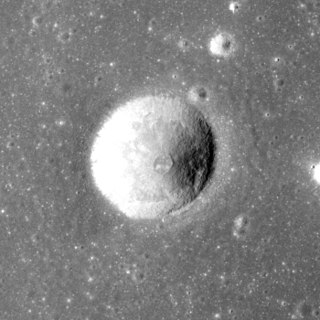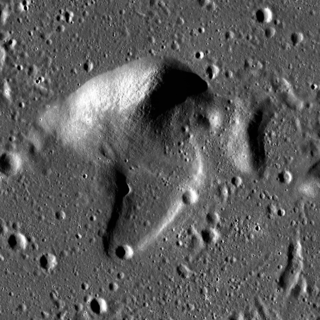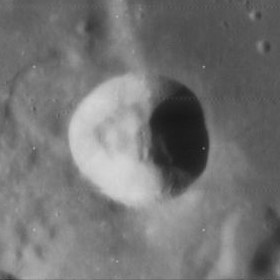
Aryabhata, named after Indian astronomer Aryabhata, is the remnant of a lunar impact crater located in the eastern Mare Tranquillitatis. The crater has been almost submerged by lava-flow, and now only an arc-shaped ridge formed from the eastern half of the rim remains above the lunar mare. This crater was previously identified as Maskelyne E before being named by the IAU in 1979. Maskelyne itself is to the southwest.

Borel is a tiny lunar impact crater located in the southeast part of Mare Serenitatis. It was named after French mathematician Émile Borel. To the northeast is the crater Le Monnier and to the southeast is the crater Abetti. Borel was previously identified as Le Monnier C.

Finsch is a relatively small lunar impact crater in the mid-part of Mare Serenitatis that has been almost completely covered by the mare, forming a ghost crater in the lava plain. It was named after German zoologist Otto Finsch. It is located to the south-southeast of the crater Sarabhai and northeast of Bessel.

Al-Marrakushi is a small, relatively isolated lunar impact crater in the eastern Mare Fecunditatis. It is a circular, symmetrical formation, with inner walls that slope down to the midpoint. To the northeast is the prominent crater Langrenus. The mare near Al-Marrakushi is marked by ray material from its larger neighbor.

Abbot is a small lunar impact crater that lies on the rugged ground between the Mare Fecunditatis in the south and west, and the Mare Crisium to the north. It is a circular crater with a cup-shaped interior. The inner walls slope downward to the midpoint, and no impacts of significant mark the interior or the rim.

Al-Bakri is a small lunar impact crater on the northwest edge of Mare Tranquillitatis. It is named after the Spanish Arab geographer and historian Abu Abdullah al-Bakri. It is just south of the eastern arm of the Montes Haemus that borders the Mare Serenitatis to the north. To the east-northeast is the prominent crater Plinius. South of the crater are the rilles of the Rimae Maclear.

Anville is a relatively small, solitary lunar impact crater located in the north part of the Mare Fecunditatis. It is named after French cartographer Jean-Baptiste d'Anville. This is a circular, cup-shaped formation with a sharp edge and little appearance of wear. Some minor slumping has occurred in the eastern half of the interior wall. It was designated Taruntius G prior to being assigned a name by the IAU. Taruntius itself lies to the north-northwest, at the edge of the mare.

Asada is a small lunar impact crater located at the northern edge of Mare Fecunditatis, to the northeast of the crater Taruntius. It is a circular crater formation with inner walls that slope down toward a small central floor at the midpoint. Asada was designated Taruntius A prior to being named by the IAU.

Beketov is a small lunar impact crater that lies in the northern reaches of the Mare Tranquillitatis. It is named after Russian chemist Nikolay Beketov. To the south is the ghost crater Jansen R. Northeast of Beketov, along the edge of the mare, is the crater Vitruvius. Beketov was previously designated Jansen C before being named by the IAU. The flooded crater Jansen itself lies to the south.

Carrillo is a small lunar impact crater located near the eastern limb of the Moon. In this location the crater is subject to lunar libration effects, and appears highly oval due to foreshortening. It is located on the slope of highlands on the west side of Mare Smythii, and its inner wall is wider on the western side than to the east.

Crile is a tiny lunar impact crater. It is roughly circular and cup-shaped, with interior walls that slope down to the midpoint. The crater lies in the Palus Somni, between the Mare Crisium to the east and Mare Tranquillitatis to the west.

Bohnenberger is a lunar impact crater that lies near the east edge of the Mare Nectaris, in the foothills of the Montes Pyrenaeus mountain range that forms the perimeter of the mare. To the east beyond the mountains is the larger crater Colombo.

Doppelmayer is the remains of a lunar impact crater that lies on the southwest edge of Mare Humorum. To the south-southeast is another flooded crater designated Lee, and to the southeast is Vitello. Just to the east-northeast of Doppelmayer lies the nearly submerged crater Puiseux.

Fedorov is a lunar geologic feature located in the western Mare Imbrium named after Russian rocket scientist Aleksandr Petrovich Fedorov. It lies east-northeast of the crater Diophantus, and southeast of Delisle. About 20 kilometers to the south-southeast is the slightly larger formation of Artsimovich.

Boss is a lunar impact crater that is located along the northeast rim of the Moon's near side. Due to its location, the crater is viewed from the side by observers on the Earth, and its visibility is subject to libration effects. It was named by the IAU in 1964 for astronomer Lewis Boss.

Bellot is a small lunar impact crater that is located on the southwest edge of Mare Fecunditatis. It lies between the craters Goclenius to the northwest and Crozier to the southeast. To the southwest is Colombo, and to the west is Magelhaens.

Drude is a lunar impact crater that lies on the far side of the Moon, in the rugged Montes Cordillera range that forms the outer ring around the Mare Orientale impact basin. It is located just behind the west-southwest limb, and this area is sometimes brought into sight from Earth during favorable librations. However, even at such times, the crater is viewed from the edge and little detail can be seen.

Eckert is a tiny, isolated lunar impact crater in the northern part of the Mare Crisium. This crater forms a circular pit in the dark surface of the surrounding lunar mare. Just to the west is a wrinkle ridge in the mare surface, a feature that is prominent only under oblique lighting from the Sun. The nearest craters of note are Peirce to the west-northwest, and Picard to the southwest. Both of these craters lie in the Mare Crisium basin.

Courtney is a tiny lunar impact crater on the Mare Imbrium, a lunar mare in the northwest quadrant of the Moon. It lies about two crater diameters to the northwest of Euler, in an otherwise isolated stretch of the mare. The dark surface in this region is marked by Euler's ray material. The name is an English male name.

Chalonge is a lunar impact crater that is located on the far side of the Moon. It lies to the southwest of the larger crater Lewis, in the outer skirt of ejecta that surrounds the Mare Orientale impact basin. To the southeast are the Montes Cordillera, a ring of mountains that encircle the Mare Orientale formation.




















